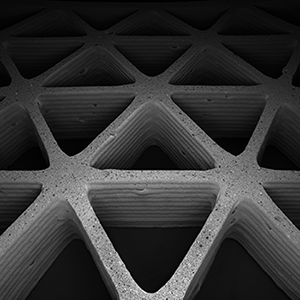 Metal may be the biggest thing in 3D printing right now, but ceramics are beginning to catch up to their fellow materials as new methods are developed for printing the notoriously difficult medium. Just yesterday, Nano Dimension announced that they will be working on a new ceramic inkjet 3D printing technology, while a team of Harvard researchers have come up with a novel ceramic printing method that holds a lot of potential for industries ranging from medicine to construction – despite its strangeness.
Metal may be the biggest thing in 3D printing right now, but ceramics are beginning to catch up to their fellow materials as new methods are developed for printing the notoriously difficult medium. Just yesterday, Nano Dimension announced that they will be working on a new ceramic inkjet 3D printing technology, while a team of Harvard researchers have come up with a novel ceramic printing method that holds a lot of potential for industries ranging from medicine to construction – despite its strangeness.
One of the issues that has plagued ceramic 3D printing is the fact that the material tends to be heavy and dense. Researchers from the Harvard John A. Paulson School of Engineering and Applied Sciences (SEAS), the Wyss Institute for Biologically Inspired Engineering at Harvard University, and MIT have circumvented that issue by creating a ceramic foam that can be used to print lightweight structures with independently controllable macro- and micro-scale porosity. The material was inspired by the structure of grass, which is strong and robust despite its light weight.
Think about it – grass weighs practically nothing, yet it’s better equipped to handle strong winds and other forces of nature than most trees are. If you step on it, it may bend, but it then slowly rises back to its upright form. The strength and resilience of grass is due to its hollow, tubular macrostructure as well as its porous cellular microstructure, the combination of which the researchers studied when developing the new material.
“By expanding the compositional space of printable materials, we can produce lightweight structures with exceptional stiffness,” said Jennifer Lewis, Hansjorg Wyss Professor of Biologically Inspired Engineering at SEAS and Core Faculty Member of the Wyss Institute. “This work represents an important step toward the scalable fabrication of architected porous materials.”
The ceramic foam ink developed in Lewis’ lab is composed of alumina particles, air, and water, and could potentially be used to 3D print thermal insulation, tissue scaffolds and lightweight structural materials.
The researchers were able to fine-tune the foam ink’s properties by controlling its microstructure. Once they had optimized the material to their satisfaction, they used it to 3D print lightweight triangular and hexagonal honeycomb structures with scalable density, stiffness and geometry.“Foam inks are interesting because you can digitally pattern cellular microstructures within larger cellular macrostructures,” said Joseph Muth, a graduate student in the Lewis Lab. “After the ink solidifies, the resulting structure consists of air surrounded by ceramic material on multiple length scales. As you incorporate porosity into the structure, you impart properties that it otherwise would not have.”
“This process combines the best of both worlds,” said Lorna Gibson, the Matoula S. Salapatas Professor of Materials Science and Engineering at the Massachusetts Institute of Technology. “You get the microstructural control with foam processing and global architectural control with printing. Because we’re printing something that already contains a specific microstructure, we don’t have to pattern each individual piece. That allows us to make structures with specific hierarchy in a more controllable way than we could do before.”
While the research team focused on one ceramic material, the potential for creating printable foam inks extends to other types of ceramics as well as metals and polymers.
“We can now make multifunctional materials, in which many different material properties, including mechanical, thermal, and transport characteristics, can be optimized within a structure that is printed in a single step,” said Muth.
The research is being published in a paper co-authored by Lewis, Muth, Gibson, Patrick G. Dixon and Logan Woish in the Proceedings of the Natural Academy of Science. The work was supported by the National Science Foundation and the Harvard Materials Research Science and Engineering Center. Harvard’s Office of Technology Development has filed a patent application and is examining the possibilities of commercializing the technology. See how the foam is created in the video below:
Discuss in the Ceramic Foam Ink forum at 3DPB.com.
[Source: Harvard]
Subscribe to Our Email Newsletter
Stay up-to-date on all the latest news from the 3D printing industry and receive information and offers from third party vendors.
You May Also Like
Gorilla Sports GE’s First 3D Printed Titanium Cast
How do you help a gorilla with a broken arm? Sounds like the start of a bad joke a zookeeper might tell, but it’s an actual dilemma recently faced by...
Nylon 3D Printed Parts Made More Functional with Coatings & Colors
Parts 3D printed from polyamide (PA, Nylon) 12 using powder bed fusion (PBF) are a mainstay in the additive manufacturing (AM) industry. While post-finishing processes have improved the porosity of...
$25M to Back Sintavia’s Largest Expansion of Metal 3D Printing Capacity Since 2019
Sintavia, the digital manufacturing company specializing in mission-critical parts for strategic sectors, announced a $25 million investment to increase its production capacity, the largest expansion to its operations since 2019....
Velo3D Initiates Public Offering in a Bid to Strengthen Financial Foundations and Drive Future Growth
Velo3D (NYSE: VLD) has been among a number of publicly traded 3D printing firms that have attempted to weather the current macroeconomic climate. After posting a challenging financial report for 2023,...































